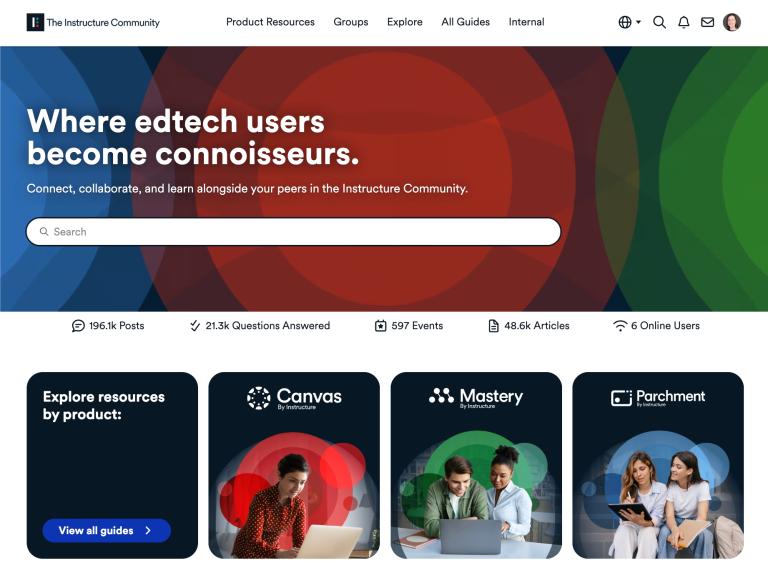In early 2020, as learning moved rapidly online, a key issue surfaced at every level of education: how to make learning accessible for every student. Whether it was students with disabilities or those who lacked access to devices or high speed internet, the rush to distance learning dramatically increased existing challenges of delivering inclusive learning to all.
Now, a year later, as we celebrate the 10th annual Global Accessibility Awareness Day there is a silver lining of facing these challenges: increased awareness and discussions on how best to provide equitable access to learning. While much of the debate around online learning has focused on what has been lost without the on-campus experience -- and the impact on student experience has certainly been significant -- we have discovered some of the ways educational technology can make learning more accessible.
1) Your learning management system is (most likely) designed for accessibility.
Simply leveraging the tools within your LMS can go a long way to better serving every student. Most leading learning technology tools are built to meet a common standard, in this case Web Content Accessibility Guidelines (WCAG), which were developed to provide a single, shared standard to make web content more accessible to anyone with disabilities. Canvas LMS, for instance, is certified WCAG 2.1 AA substantially conformant by a non-profit third party. This means much of the work of ensuring accessibility tools and assistive technology will properly work with your courses.
Some learning management tools go a step further, providing native accessibility tools. Canvas features a built-in Accessibility Checker in the Rich Content Editor tool that checks for common accessibility errors while an educator is building out their course content. An example might be ensuring the use of color blind-friendly visualizations and alternate text for images for the visually impaired. It’s also easy to add captioning to a video created in or uploaded to a Canvas course. These simple features take much of the guesswork out of creating accessible courses.
It’s also important to choose an LMS that easily integrates with third party accessibility tools that can extend the capabilities required to meet the needs of diverse students. For instance, Canvas easily integrates with tools such as Microsoft Immersive Reader and Blackboard Ally to help meet learners wherever they are.
2) Consider the student user experience across your institution.
Even before the growth in online learning associated with the pandemic, one of the biggest pieces of feedback received by LMS developers was, “make my professor use the technology more, and make them use it more consistently.” For most students, the experience differs drastically from one course to another. A study by the EDUCAUSE Center for Analysis and Research (ECAR) from 2020 showed this desire was especially acute in students with disabilities. The need for greater consistency has long plagued institutions trying to balance the academic freedom of their faculty with the expectations of increasingly tech-immersed students. And this inconsistency can have a negative impact on student engagement and outcomes.
While the level of instructional design support and general comfort with adopting technology may always vary wildly, we can raise the bar on improving the student experience by simply modeling best-practices and making them aware of the tools at their disposal. Delivering templates by institution or department that help create visual consistency is a solid first step. Outlining tips and tricks for educators new to deeply adopting an LMS, and aligning them with “LMS power-users,” can be incredibly helpful. Making them part of a community of educators who learn together and share their achievements is one of the reasons the Canvas Community has grown to more than a million active users.
Most of all, identifying those aspects that make the online and blended classroom unique and not trying to simply recreate the physical classroom is key. Small steps like prioritizing asynchronous delivery through discussions, groups, and collaborations while still including some synchronous elements can have a measurable impact on student engagement outcomes.
3) Design with mobile in mind.
I’ve spoken with educators, especially those whose institutions serve lower income and working student populations, who truly believed their students largely did not own smartphones. Data shows that not to be the case. A 2017 study by ECAR revealed that 99% of U.S. undergraduate students own a smartphone. A Pew Research study from April of this year found that 96% of the U.S. population ages 18-29 own a smartphone. As computer labs on campuses across the globe shut down and many students struggled to access laptop or desktop computers, the same students almost universally had access to a device capable of accessing their courses right in their pockets.
By acknowledging the ubiquity of mobile devices and embracing them, not as a distraction but as a primary mode of connecting with students, we can begin to optimize our course design to meet students where they spend their time. Simply understanding that students prefer to use native mobile apps that leverage notifications and the tools built right into their phones as opposed to the often clunky process of accessing course content through a mobile browser can have serious implications on course creation.
One thing is clear -- education is in the midst of change. And during times of rapid change we cannot lose sight of how essential accessibility is for millions of students and educators alike. In fact, we need to double-down on our commitment to accessible design. By identifying and adopting best practices in technology usage will help us continue to serve the evolving educational landscape.
Related Content
 inst-3step.jpg
inst-3step.jpgBlogs
 13lmsfeaturesthatbenefitstudentlearning.jpg
13lmsfeaturesthatbenefitstudentlearning.jpgBlogs
 community-homepage.jpg
community-homepage.jpgBlogs

